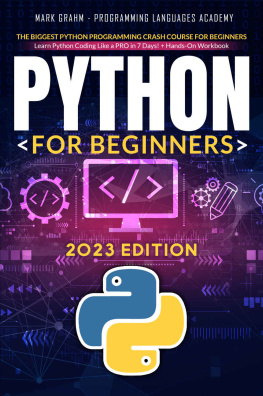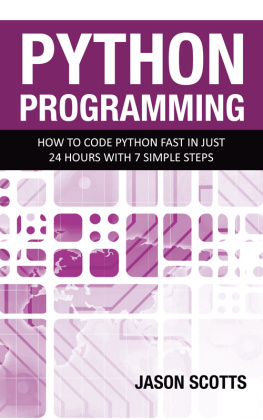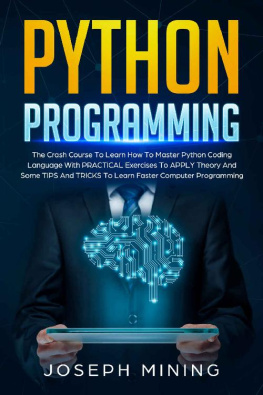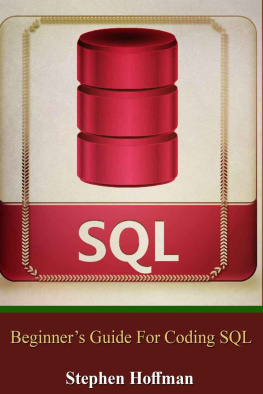PYTHON crash course
Beginner guide to computer programming, web coding and data mining. Learn in 7 days machine learning, artificial intelligence, NumPy and Pandas packages with exercises for data analysis.
JASON TEST
Copyright 2020 - All rights reserved.
The content contained within this book may not be reproduced, duplicated or transmitted without direct written permission from the author or the publisher.
Under no circumstances will any blame or legal responsibility be held against the publisher, or author, for any damages, reparation, or monetary loss due to the information contained within this book. Either directly or indirectly.
Legal Notice:
This book is copyright protected. This book is only for personal use. You cannot amend, distribute, sell, use, quote or paraphrase any part, or the content within this book, without the consent of the author or publisher.
Disclaimer Notice:
Please note the information contained within this document is for educational and entertainment purposes only. All effort has been executed to present accurate, up to date, and reliable, complete information. No warranties of any kind are declared or implied. Readers acknowledge that the author is not engaging in the rendering of legal, financial, medical or professional advice. The content within this book has been derived from various sources. Please consult a licensed professional before attempting any techniques outlined in this book.
By reading this document, the reader agrees that under no circumstances is the author responsible for any losses, direct or indirect, which are incurred as a result of the use of information contained within this document, including, but not limited to, errors, omissions, or inaccuracies.
TABLE OF CONTENTS
Day 1
What Is Python?
P ython is a high-level, object-oriented, construed programming language with complex semblance. Combined with dynamic typing and dynamic binding, its high-level data structures make it very attractive for Rapid Application Development as well as for use as a scripting or glue language for connecting existing components. Python's quick, easy to understand syntax, stresses readability, and hence reduces the expense of running the software. Python connects modules and packages that promote the modularity of the software and reuse of code. For all major platforms, the Python interpreter and the comprehensive standard library are available free of charge in source or binary form and can be freely distributed.
Programmers also fall in love with Python because of the increased productivity it brings. The edit-test-debug process is amazingly quick since there is no compilation phase. Python debugging programs are simple: a mistake or bad feedback would never trigger a segmentation fault. Alternatively, it creates an exception when the translator detects an error. If the program miscarries to catch the exception, the parser will print a stack trace. A source-level debugger allows you to inspect local and global variables, check arbitrary expressions, set breakpoints, walk through the code one line at a time, etc. The debugger itself is written in Python, testifying to the introspective power of Python. On the other side, often the fastest way to debug a system is to add a few print statements to the source: the quick process of edit-test-debug renders this simple approach quite efficient.
Who is the Right Audience?
The resolve of this book is to get you up to speed with Python as easy as possible so that you can create programs that work games, data analysis, and web applications while building a programming base that will serve you well for the rest of your life. Python Crash Course is designed for people of any age who have never programmed in or worked in Python before. This book is for you if you want to learn the basics of programming quickly so you can focus on interesting projects, and you like to test your understanding of new concepts by solving meaningful issues. Python Crash Course is also great for middle and high school teachers who would like to give a project-based guide to programming to their pupils.
What You Will Learn?
The sole purpose of this book is to make you generally a good programmer and, in particular, a good programmer for Python. As we provide you with a solid foundation in general programming concepts, you can learn quickly and develop good habits. You should be prepared to move on to more sophisticated Python methods after working your way through the Python Crash Course, and it will make the next programming language much easier to grasp. You will learn basic programming concepts in the first part of this book, which you need to know to write Python programs. These concepts are the same as those you would learn in almost any programming language when starting out.
You can learn about the different data types and ways you can store data within your applications in lists and dictionaries. You'll learn how to build data collections and work efficiently through those collections. You'll learn to use while and when loops to check for certain conditions so that you can run certain sections of code while those conditions are true and run certain sections when they aren't true a strategy that can significantly automate processes. To make your programs accessible and keep your programs going as long as the user is active, you'll have to accept input from users. You 're going to explore how to apply functions as reusable parts of your software, and you only have to write blocks of code that execute those functions once, which you can use as many times as you want. You will then extend this concept with classes to more complicated behavior, making programs fairly simple to respond to a variety of situations.
You must learn how to write programs to handle common errors graciously. You will write a few short programs after going on each of these basic concepts, which will solve some well-defined problems. Finally, you can take the first step towards intermediate programming by learning how to write checks for your code so that you can further improve your programs without thinking about bugs being implemented. For Part I, all the details will allow you to take on bigger, more complicated tasks.
Why Python?
Every year we consider whether to continue using Python or move on to another language maybe one that is newer to the programming world. But for a lot of reasons, I keep on working on Python. Python is an incredibly efficient language: the programs will do more than many other languages will need with fewer lines of code. The syntax of Python, too, should help write clean code. Compared to other languages, the code will be easy to read, easy to debug, and easy to extend and expand on. People use Python for many purposes: making games, creating web applications, solving business problems, and developing internal tools for all types of applications interesting ventures. Python is also heavily utilized for academic research and theoretical science in scientific fields.
One of the main reasons I keep on using Python is because of the Python community, which includes an incredibly diverse and welcoming group of people. Community is important for programmers since programming is not a practice of solitude. Most of us will ask advice from others, even the most seasoned programmers, who have already solved similar problems. Getting a well-connected and supportive community is essential to help you solve problems and the Python community fully supports people like you who are using Python as your first programming language.






